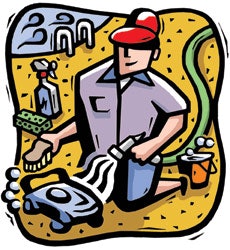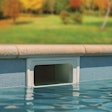Automatic pool cleaners are self-sufficient tools that work wonders on keeping a pool glistening and debris-free. But even a cleaner needs routine maintenance and care every once in a while in order to operate at its maximum capacity. AQUA spoke with the experts themselves — the manufacturers — and got the 411 on keeping an automatic cleaner ready to roll (pun intended) at all times. Following are a few tips for maximizing automatic pool cleaner productivity.
Know Your Application

It's not always the residential client who may need help in finding a cleaner appropriate for the job. "It might be tempting for a commercial serviceperson to buy a robotic cleaner that's designed for residential use and use it commercially or use it on his customers' pools every day," says Shulman. "Aside from the fact that it's not meant to do that, you are also voiding the warranty."
Let your clients know about any warranty restrictions and regulations before they purchase a cleaner. "Many models do have ways of being diagnosed to see how many hours it has been used," adds Shulman. Being straightforward with a client about what's covered under a manufacturer's warranty can save time and money in the future, not to mention give the client peace of mind.
Heart Of The Matter
While robotic cleaners operate off an independent booster pump, pressure-side and suction-side cleaners rely on the pool's system. Keeping the filter — or other media — clean is an absolute must."I think sometimes people forget the system," says Manuela Rief, vice president of Poolvergnuegen. "If the filter is dirty, the cleaners start to slow down, maybe even stop." A dirty system is one of the biggest challenges this category faces, says Rief, and it requires knowledgeable retailers in addition to servicepeople and builders.
"The service guys are in the backyard, the builders are sometimes in the backyard, so they can actually see and they can take care of any issues very, very quickly. Whereas the retailers, they operate like somebody on the telephone, sight unseen, so a lot of times they don't know what's going on.
"I think it's more critical for them to say, 'Have you checked the filter, have you checked this, have you checked that?'" adds Rief.
Keep It Clean
"When removing [all types of] cleaners from the pool, always rinse off the entire cleaner and its working components," recommends Gil Erlich, vice president of sales and marketing for Aqua Products. "This will reduce the chlorine and whatever chemicals may be on it, reducing the degradation and wear and tear of parts." In addition to hosing off the equipment, Shulman says keeping it out of the elements and off the ground will also help."You might want to get a caddy for your cleaner so it's not resting on your pavement or pavers or whatever your deck is," says Shulman. Rough surfaces can scratch skirts, wings and tires, leaving irregularities that may affect the cleaning of the pool or the cleaner's operation.
Erlich likens the robotic cleaners to a household vacuum and recommends taking it out of the pool when it's not in use. "I know the culture in many parts of the country is to leave the cleaner in the pool at all times. Because [the robotic cleaner] is independent of the pool filter, it operates like a house vacuum, and you don't leave a house vacuum in the living room. When you need it, you roll it in. And when you don't, you take it out."
Not only does the customer have a more aesthetically pleasing pool without a vacuum, but it also reduces the risk of wearing out the cleaner by constantly keeping it in the pool.
Knowledge Is Power
"I am an absolute advocate that any dealer who sells a product, especially a technical product, should know how to service that product as a benefit to their customer so that the customer isn't forced now to ship the product elsewhere, in particular not to a competitor who may be a service center," says Erlich. "Knowledge is power, and power and knowledge are profitable."Erlich recommends taking advantage of manufacturers' service center training or certification programs, including attending any educational courses, seminars or product overviews at industry trade shows. A better understanding of any product allows for better customer service, which in return brings in more customers and ultimately more revenue.
Screen Test
Marchal DePasquale, director of marketing for the cleaner division at Hayward Pool Products, acknowledges that "in different environments, the longevity of each component is different. Usually sandy environments are going to be most abusive." DePasquale recommends keeping the screens of pressure-side and suction-side cleaners clean at all times."Whatever sand or grit is being forced into the [pressure] cleaner through the main pipe, the more these screens get clogged up, the less the product will perform. So it's important to look through these screens and make sure they are free of debris," he adds. From a suction-side standpoint, the screen is located in the back of the cleaner, and DePasquale recommends cleaning that screen as well, which can easily be done with the use of a small handheld brush or toothbrush.
Check For Wear
"Even when things are worn," says Rief, "our cleaner keeps going. So the only thing we face is [when customers] neglect to change the tires because they figure it's still going so why would they have to change the tires?"Badly worn tires allow the body of the cleaner to start scraping against the surface of the pool, says Rief, hastening the wear of skirts and other underneath parts. Rief recommends checking the tires at least once during the season, along with giving the underbelly a rigorous once-over. Knowing what your cleaner looks like from below can be all telling, and because the tires are a central component to a cleaner, "if they changed the tires in a reasonable amount of time, then pretty much nothing else will wear," adds Rief.
Do It Yourself
Many cleaners afford a client the opportunity for do-it-yourself fixes. Not everyone has the resources or time to send the cleaner back to the manufacturer to check on something that could essentially be fixed at home. Shulman says SmartPool's Nitro can be fixed at home with something as simple as a screwdriver "instead of sending the cleaner back to the manufacturer and waiting weeks to get it fixed or replaced." He recommends letting clients know that if they are uncomfortable with DIY repairs, they can bring it into the dealer's store to be fixed.Rief says Poolvergnuegen has one simple way to check and see if the cleaner is having an issue that's easily fixed. "If you take our cleaner in your hands and you look at it from the rear end, and you turn the right front wheel, if the right front wheel turns, there's nothing wrong with the cleaner. If you turn the right front wheel and it's stuck, something is stuck inside the cleaner," says Rief.
Because automatic pool cleaners give clients a way to maximize the fun time in the pool and minimize cleaning time, these simple tips will only enhance a laid-back lifestyle. Backyard oases are meant to be places of rest and relaxation. By checking on an automatic pool cleaner regularly, the R&R will be that much more restful and relaxing.











































